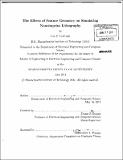The effects of feature geometry on simulating nanoimprint lithography
Author(s)
GoGwilt, Cai P. (Cai Peter)
DownloadFull printable version (5.789Mb)
Other Contributors
Massachusetts Institute of Technology. Dept. of Electrical Engineering and Computer Science.
Advisor
Duane S. Boning.
Terms of use
Metadata
Show full item recordAbstract
Nanoimprint lithography (NIL) is a method for fabricating nano-scale patterns by pressing stamps into viscous materials. A key barrier to industry adoption of NIL is the inability to predict whether a stamp will imprint successfully and how long the process should be run for. In this thesis, we help quantify the accuracy loss for an existing simulation package, simprint, which supports geometric abstractions and can simulate at the die level. To do this, we develop and study several comparison metrics. Our temporal submetric quantifies the error between two simulations at each timestep, while our spatial submetric quantifies the error at each spatial location. We subsequently use these metrics to study pattern abstraction by looking at how different types of patterns lead to different errors. This would allow us to suggest pattern abstractions that could improve the accuracy of a simulation. However, none of the features we study correlate with error. We conclude by exploring other possible uses of our metrics.
Description
Thesis (M. Eng.)--Massachusetts Institute of Technology, Dept. of Electrical Engineering and Computer Science, 2011. Cataloged from PDF version of thesis. Includes bibliographical references (p. 67-68).
Date issued
2011Department
Massachusetts Institute of Technology. Department of Electrical Engineering and Computer SciencePublisher
Massachusetts Institute of Technology
Keywords
Electrical Engineering and Computer Science.